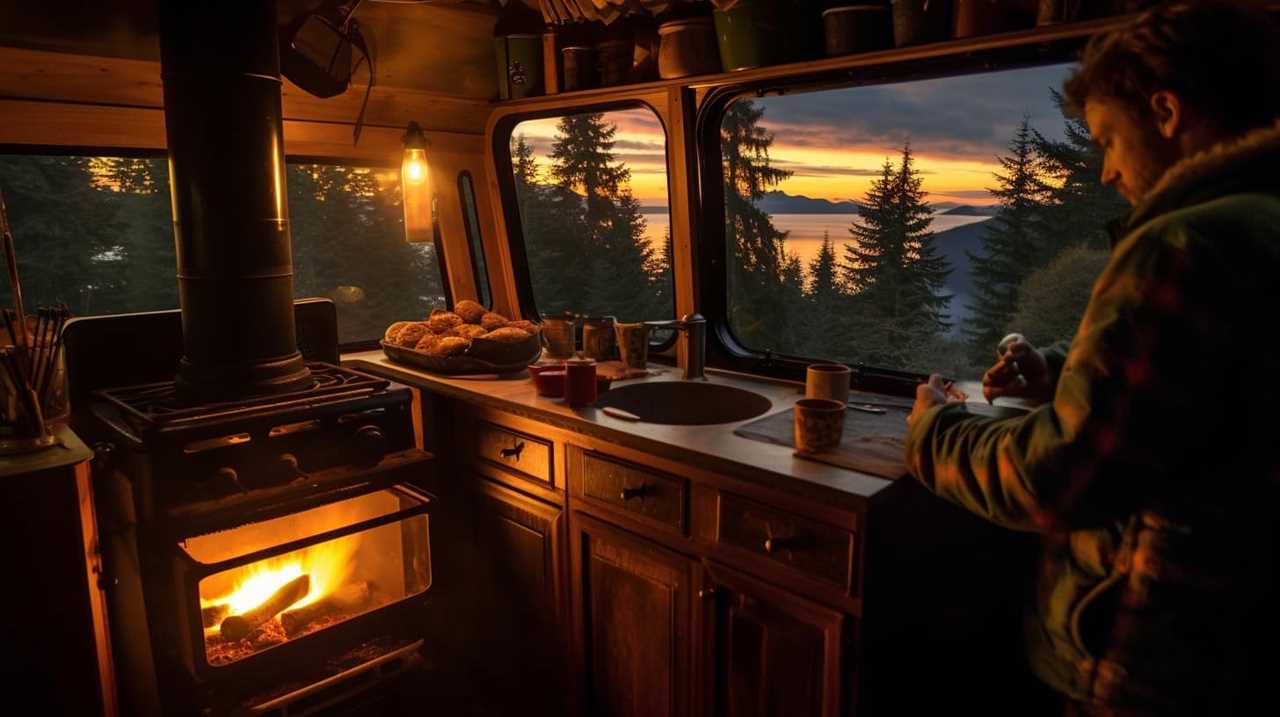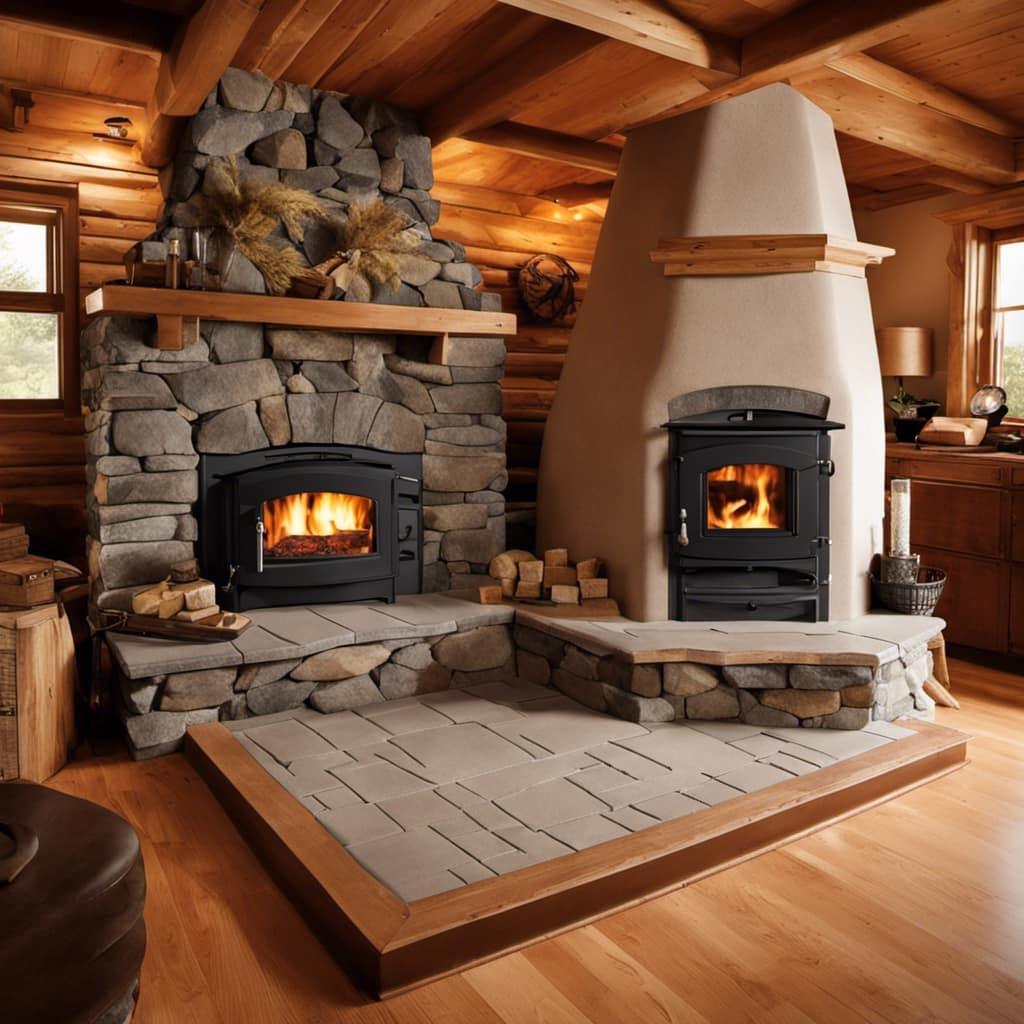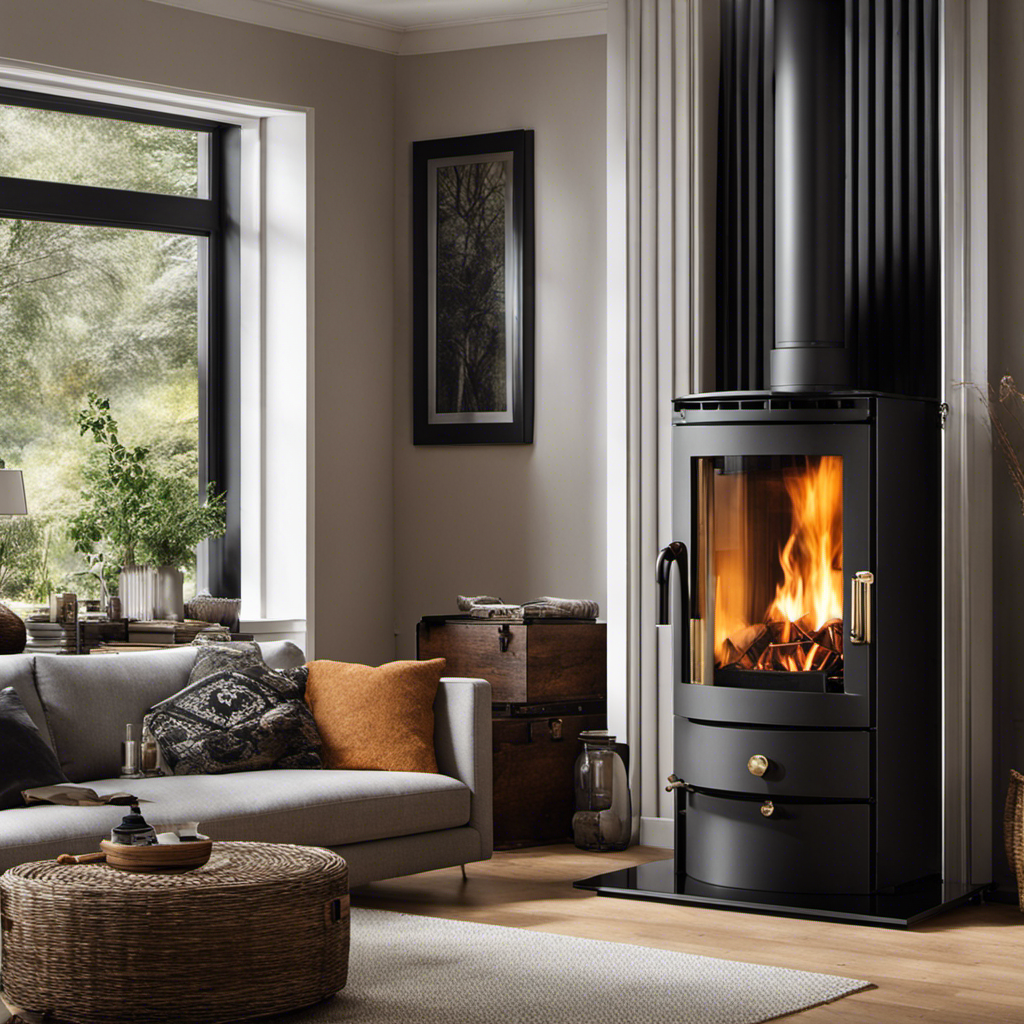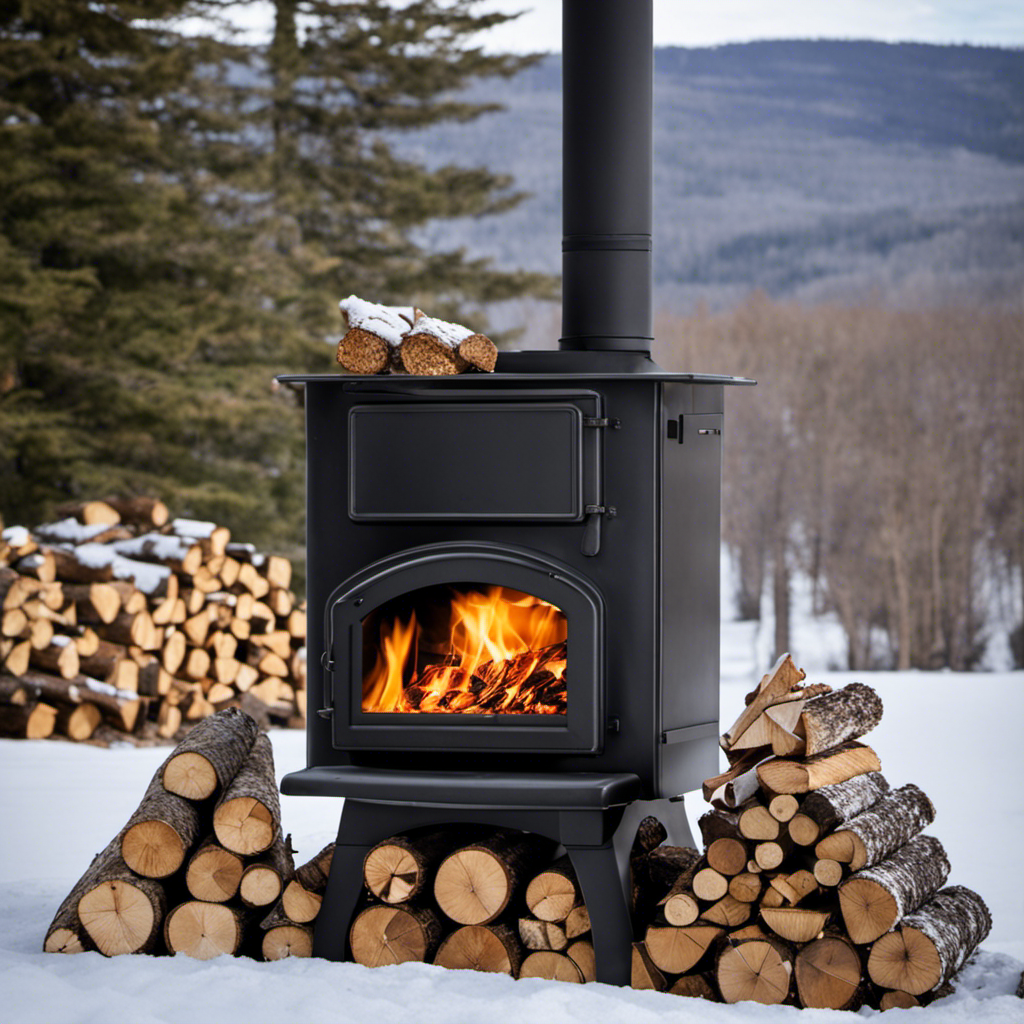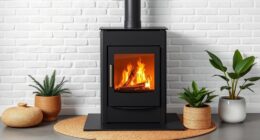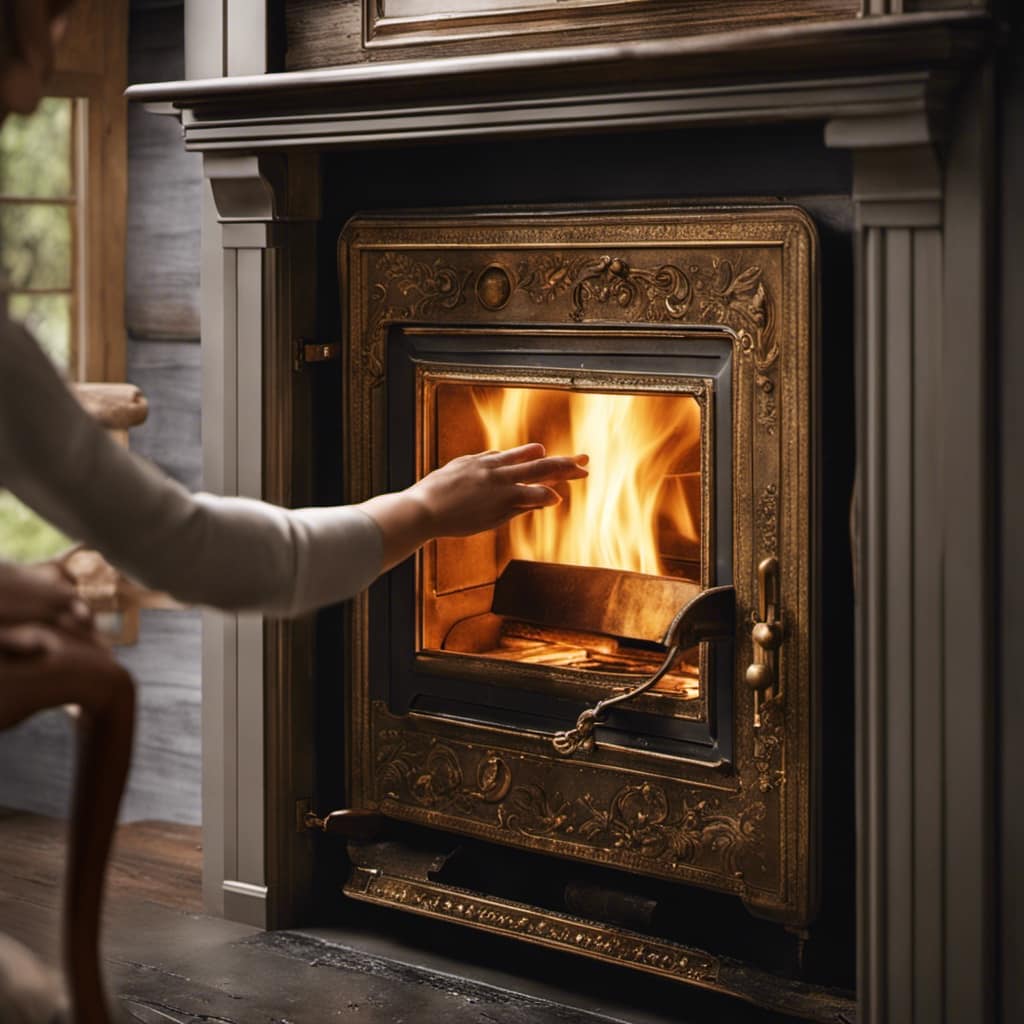
You have a wood stove and enjoy the warm heat it gives off. However, it’s evident that the glass often becomes dirty from the soot and residue buildup.
No worries though, I’ve got you covered with some simple and effective tips on how to clean that glass like a pro. From gathering the right supplies to scrubbing away stubborn soot, I’ll walk you through every step so you can enjoy a clear and sparkling view of those dancing flames.
Key Takeaways
- Regular glass cleaning improves the appearance of the stove and ensures efficient and safe operation.
- Proper cleaning techniques, such as using eco-friendly cleaners like vinegar and water, protect the environment and prevent damage to the glass.
- Removing stubborn stains can be done using a paste of baking soda and water, followed by rinsing with warm water and using lemon juice to dissolve remaining grime.
- Prevent future buildup by regularly wiping down and drying the glass, using a specialized glass cleaner or a mixture of vinegar and water, and avoiding burning materials that produce excessive smoke or ash.
Understanding the Importance of Regular Glass Cleaning
I can’t stress enough how important it’s to regularly clean the glass on a wood stove. Not only does it improve the overall appearance of the stove, but it also ensures efficient and safe operation. Over time, soot and creosote buildup can accumulate on the glass, obstructing the view of the flames and reducing heat transfer. To maintain optimal performance, it’s crucial to follow proper cleaning techniques and safety precautions.
When it comes to cleaning the glass on a wood stove, there are a few techniques you can employ. One method is to use a specialized glass cleaner designed for high-temperature applications. These cleaners are formulated to dissolve tough residues without scratching the glass. Alternatively, you can create a paste using a mixture of water and ash from the stove. Apply the paste to the glass, let it sit for a few minutes, and then wipe it off with a soft cloth.
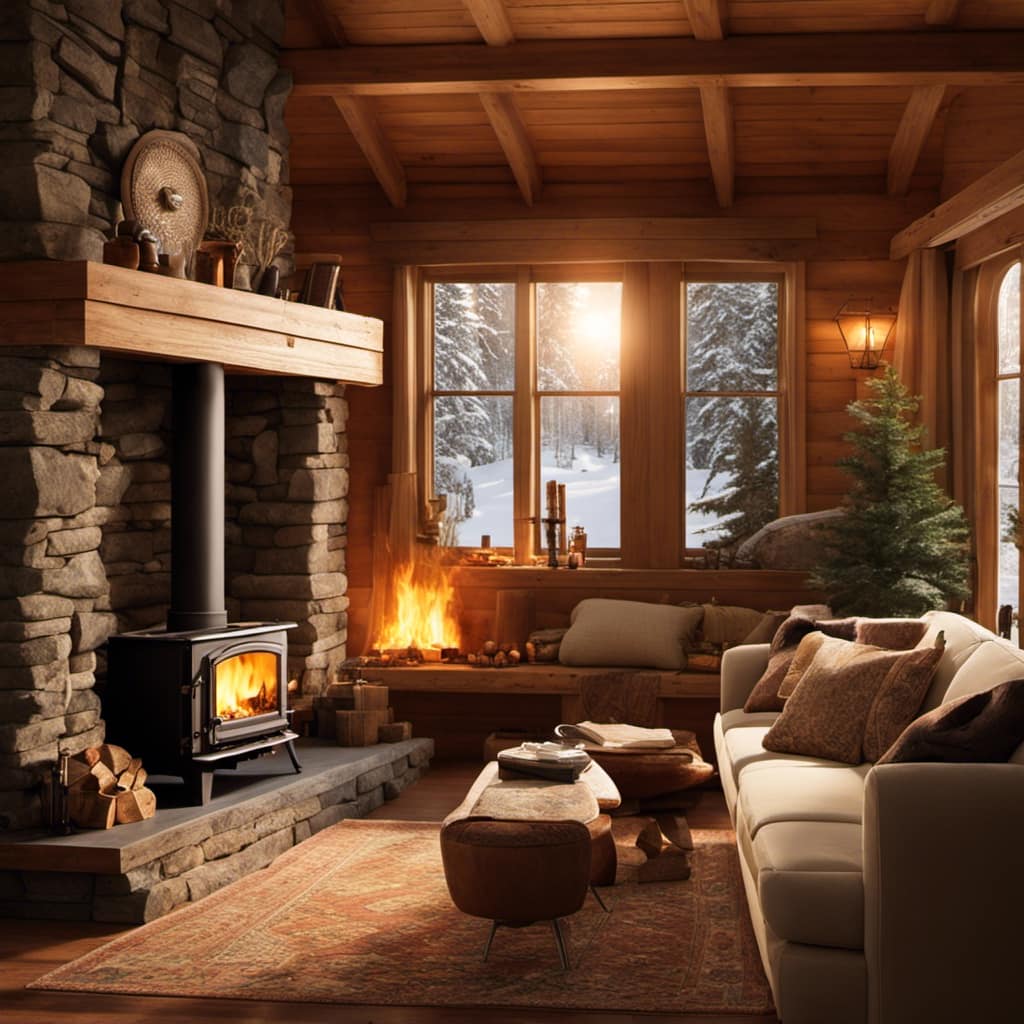
Regardless of the cleaning method you choose, safety precautions should always be a priority. Before starting the cleaning process, ensure that the wood stove is completely cool to the touch. Wear protective gloves and goggles to shield yourself from any potential hazards. Additionally, make sure the area around the stove is clear of any flammable materials.
Now that you understand the importance of regular glass cleaning on a wood stove, let’s move on to the next step: gathering the necessary cleaning supplies.
Gathering the Necessary Cleaning Supplies
To get started, I’ll need a cloth, some vinegar, and a spray bottle. Cleaning the glass on a wood stove can be a challenging task, especially when it comes to hard-to-reach areas. However, with the right tools and techniques, it can be done effectively and efficiently.
When choosing eco-friendly cleaners for this task, it’s important to opt for products that are non-toxic and safe for the environment. Vinegar is a great option as it is a natural cleaner that is both effective and environmentally friendly. It can easily remove soot and grime from the glass surface without leaving any harmful residues behind.
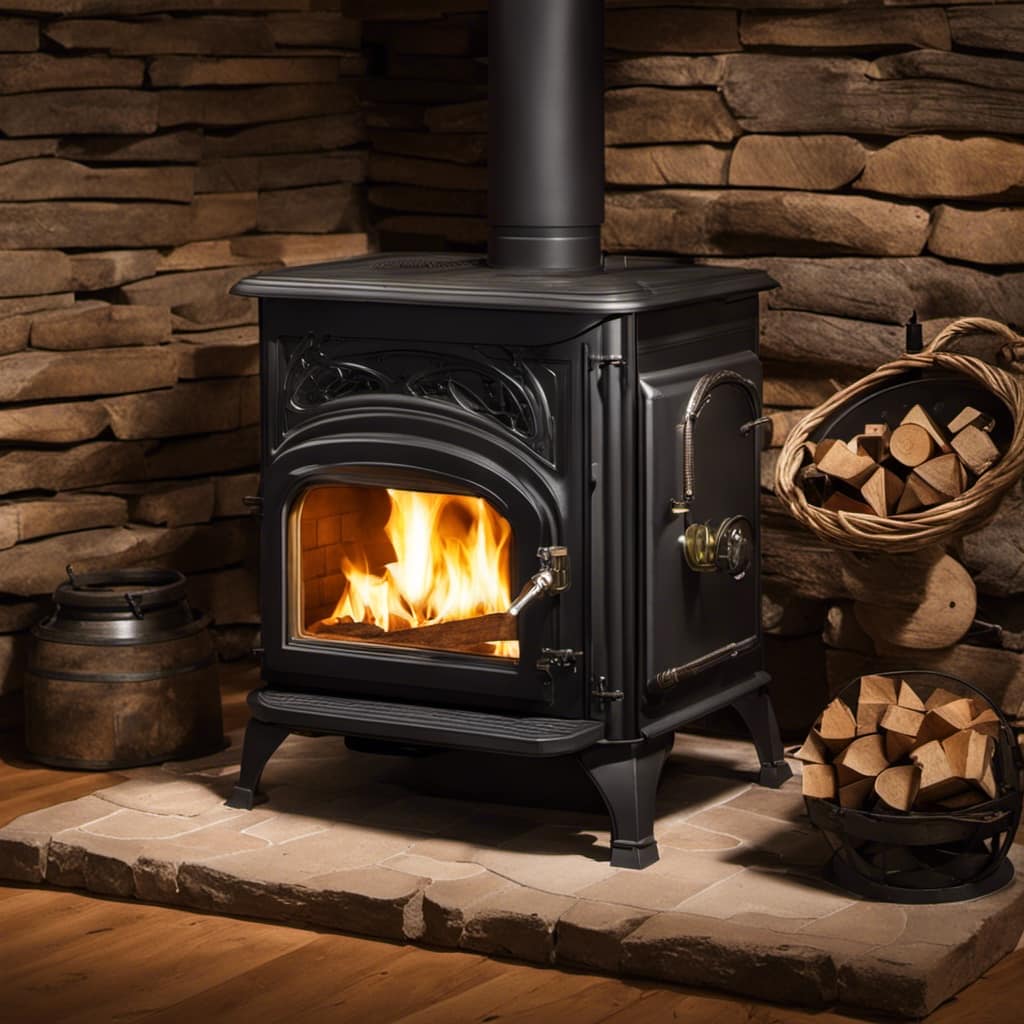
To clean hard-to-reach areas, such as the corners and edges of the glass, I recommend using a cloth or sponge attached to a long handle. This will allow you to reach those difficult spots without straining your arm or risking injury. You can also use a spray bottle to apply the vinegar solution directly onto the glass surface, ensuring an even distribution of the cleaner.
Here is a handy table summarizing the steps and tips for cleaning hard-to-reach areas on a wood stove:
| Step | Tips |
|---|---|
| 1. | Gather the necessary cleaning supplies: cloth, vinegar, and a spray bottle. |
| 2. | Choose eco-friendly cleaners to protect the environment. |
| 3. | Attach a cloth or sponge to a long handle to clean hard-to-reach areas. |
| 4. | Use a spray bottle to apply the vinegar solution evenly. |
| 5. | Take your time and be thorough in cleaning all areas of the glass. |
Preparing the Wood Stove for Cleaning
Before beginning the cleaning process, I always make sure to properly prepare the wood stove.
Firstly, I ensure that the stove is completely cooled down by waiting at least a few hours after the last fire.
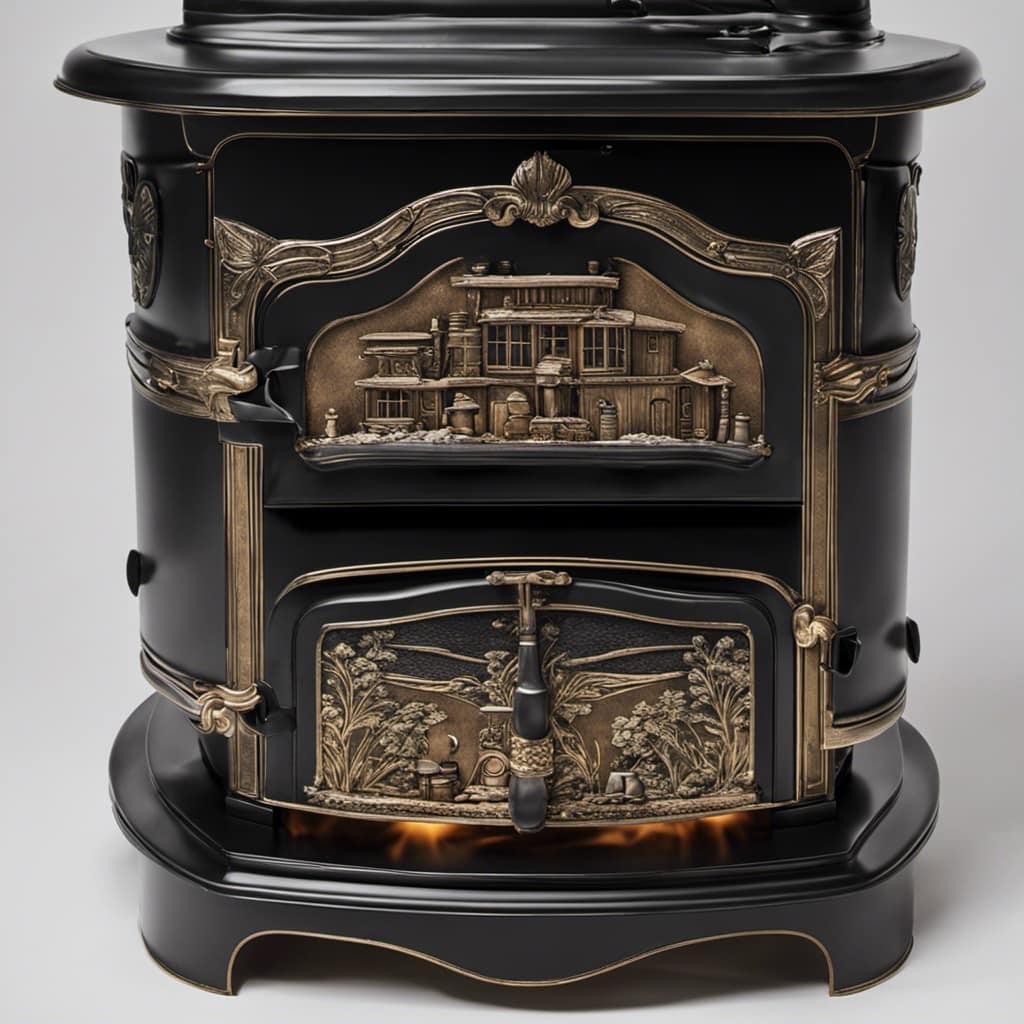
Next, I remove any remaining ashes and debris from the firebox using a metal scoop and ash bucket.
Lastly, I open all the vents and doors to allow for better airflow and ventilation during the cleaning process.
Removing Stubborn Stains
After scrubbing the glass with a mixture of vinegar and water, I noticed that the stubborn stains were still present. However, I didn’t lose hope and decided to try some other natural cleaning methods to tackle the tough grime.
I mixed baking soda with water to form a paste and applied it to the stained areas. Using a soft cloth, I gently scrubbed the paste in circular motions. The abrasive nature of baking soda helped loosen the grime, making it easier to remove.
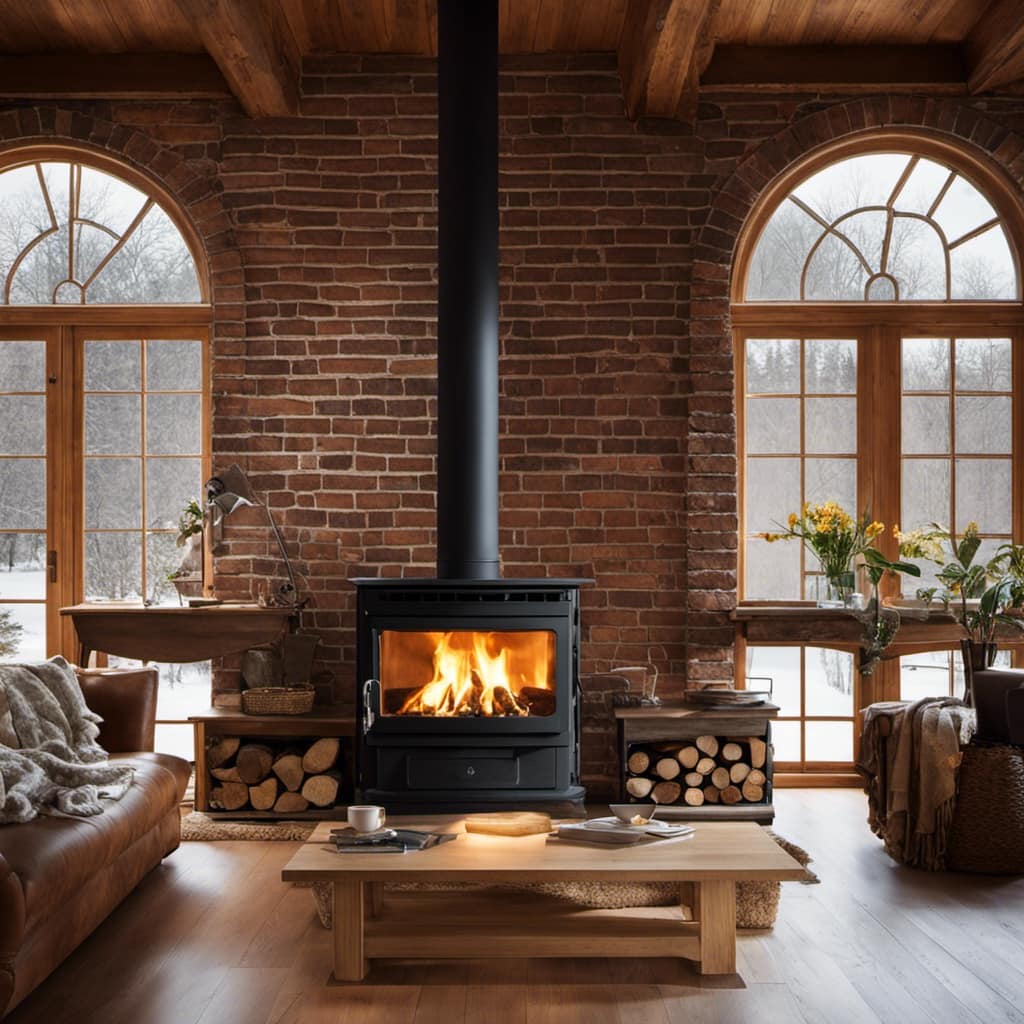
After rinsing off the paste with warm water, I was amazed to see that most of the stains had disappeared. For the remaining stubborn spots, I sprayed lemon juice directly onto the glass and let it sit for a few minutes before wiping it away. The acidic properties of lemon juice helped dissolve the remaining grime, leaving the glass sparkling clean.
Choosing the Right Cleaner
I found that using a mixture of vinegar and water was effective at removing stubborn stains from the glass. When it comes to cleaning techniques for glass on a wood stove, it’s important to choose the right cleaner to ensure both effectiveness and eco-friendliness.
Many commercial glass cleaners contain harsh chemicals that can be harmful to the environment and your health. Instead, opt for eco-friendly options such as vinegar and water. Mix equal parts of white vinegar and water in a spray bottle and spray it onto the stained glass. Let it sit for a few minutes, then wipe it clean with a soft cloth. The acidity of vinegar helps to break down the stains, while being gentle on the glass surface.
Using eco-friendly cleaning techniques not only keeps your glass clean but also helps to protect the environment. By avoiding harsh chemicals, you’re reducing your carbon footprint and promoting sustainability.
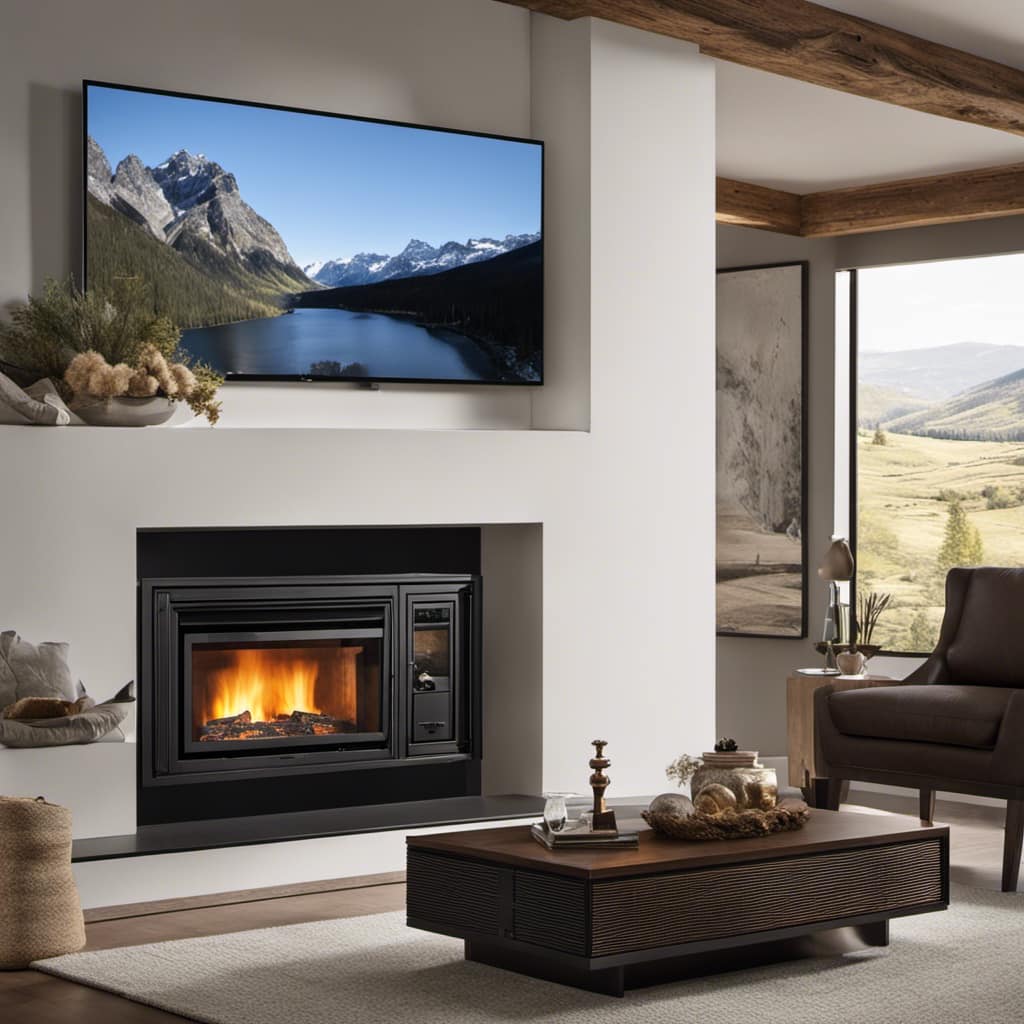
Transitioning into the next section, preventing future buildup requires regular maintenance and proper care.
Preventing Future Buildup
To maintain a clear and residue-free surface, it’s essential to regularly wipe down and dry the glass.
However, to prevent future buildup and ensure long-term glass maintenance, there are additional tips to consider.
Firstly, using a glass cleaner specifically designed for wood stoves can help remove stubborn stains and prevent residue from sticking to the glass.
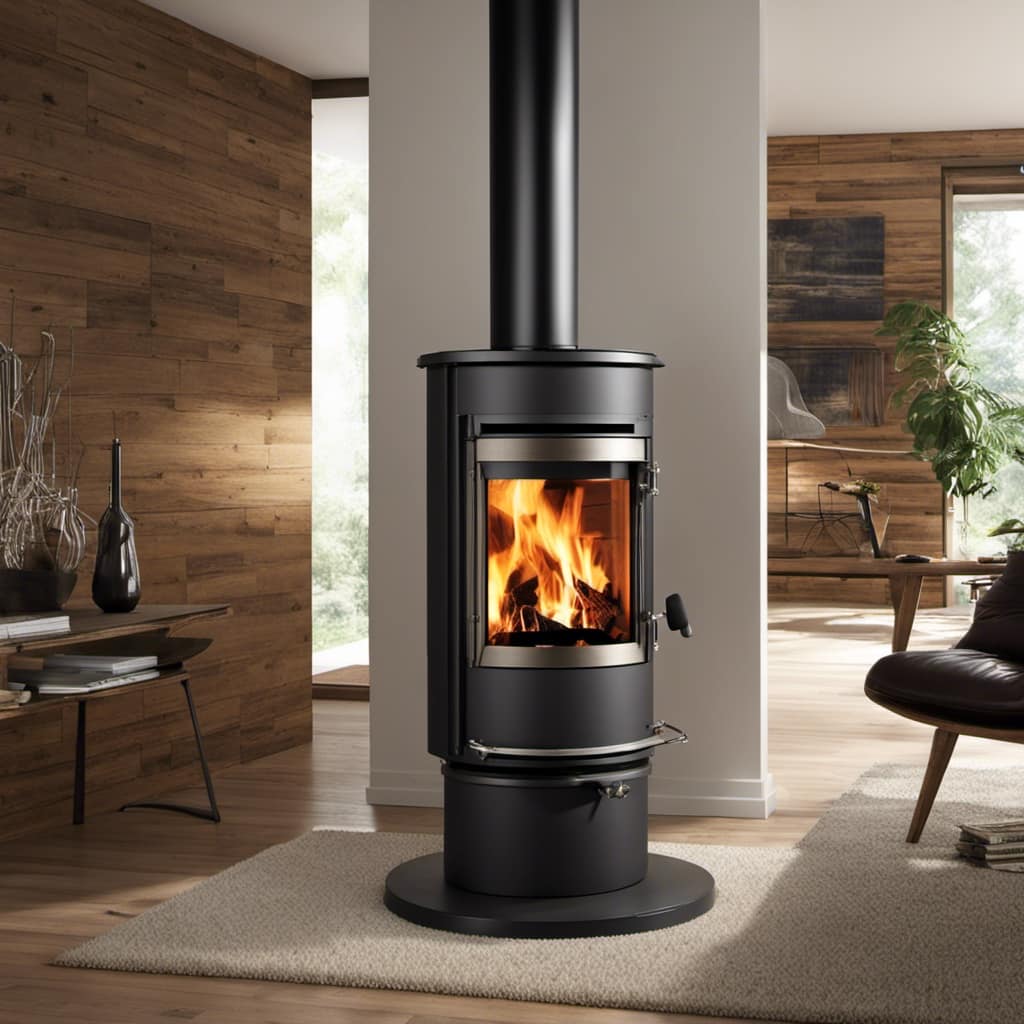
Secondly, applying a thin layer of stove glass cleaner or polish after each cleaning can create a protective barrier that makes it easier to remove soot and prevents buildup.
Additionally, avoiding burning materials that produce excessive smoke or ash can minimize the amount of residue that accumulates on the glass.
Lastly, regularly inspecting the gasket around the glass and replacing it when necessary can help maintain a tight seal and prevent air leakage, which can lead to increased soot and residue buildup.
Using Gentle Cleaning Solutions for Stubborn Soot
Stubborn soot can be effectively removed from glass on a wood stove using gentle cleaning solutions. When dealing with soot buildup, it’s important to avoid harsh chemicals or abrasive tools that can damage the glass.
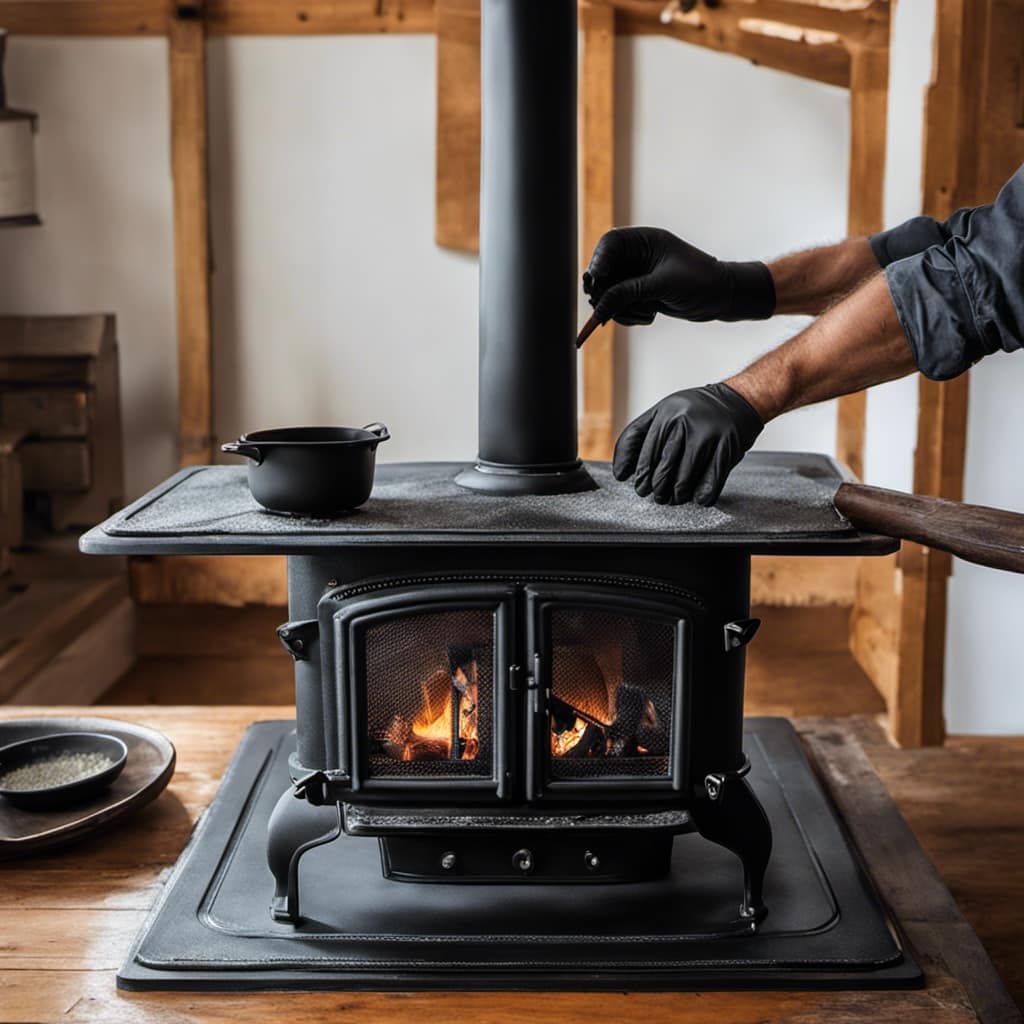
Here are some gentle cleaning methods and homemade cleaning solutions that can help you restore the clarity of your wood stove glass:
-
Vinegar and Water Solution: Mix equal parts of white vinegar and water in a spray bottle. Spray the solution onto the soot-covered glass and let it sit for a few minutes. Wipe away the residue with a soft cloth or sponge.
-
Baking Soda Paste: Make a thick paste by mixing baking soda with water. Apply the paste onto the soot stains and let it sit for about 15 minutes. Gently scrub the glass with a soft-bristle brush or sponge, and then rinse with water.
-
Lemon Juice and Salt Scrub: Combine lemon juice with table salt to create a paste. Apply the paste onto the soot stains and let it sit for a few minutes. Use a non-abrasive cloth or sponge to scrub the glass in circular motions. Rinse thoroughly with water.
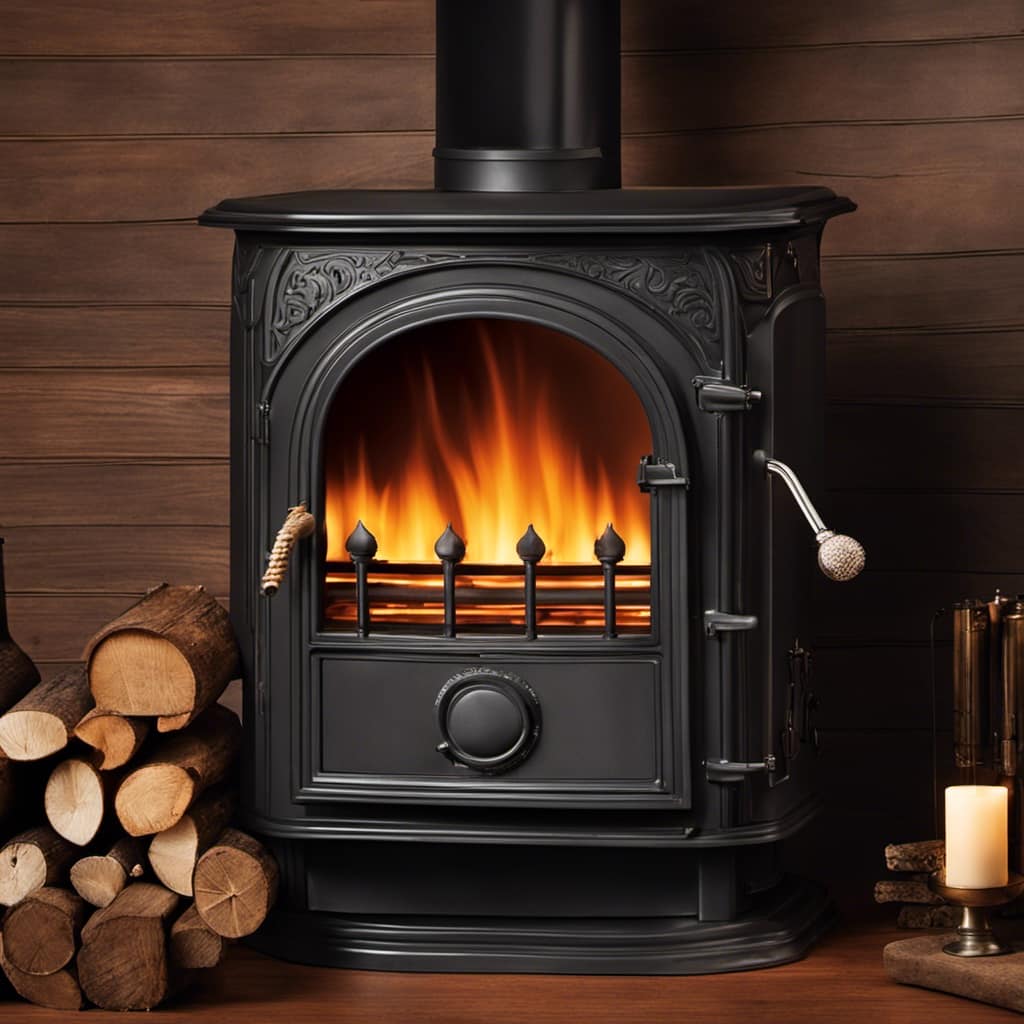
-
Dish Soap Solution: Mix a few drops of dish soap with warm water. Dip a soft cloth or sponge into the soapy solution and gently scrub the soot-covered glass. Rinse with water and dry with a clean cloth.
By using these gentle cleaning methods and homemade cleaning solutions, you can effectively remove stubborn soot from your wood stove glass without causing any damage.
Once the soot is removed, it’s time to move on to the next step: scrubbing away the remaining residue with non-abrasive tools.
Scrubbing Away Soot With Non-Abrasive Tools
When it comes to removing soot from surfaces, using non-abrasive tools is crucial to prevent any damage. Non-scratch cleaning methods are effective in getting rid of stubborn soot stains without harming the underlying surface.
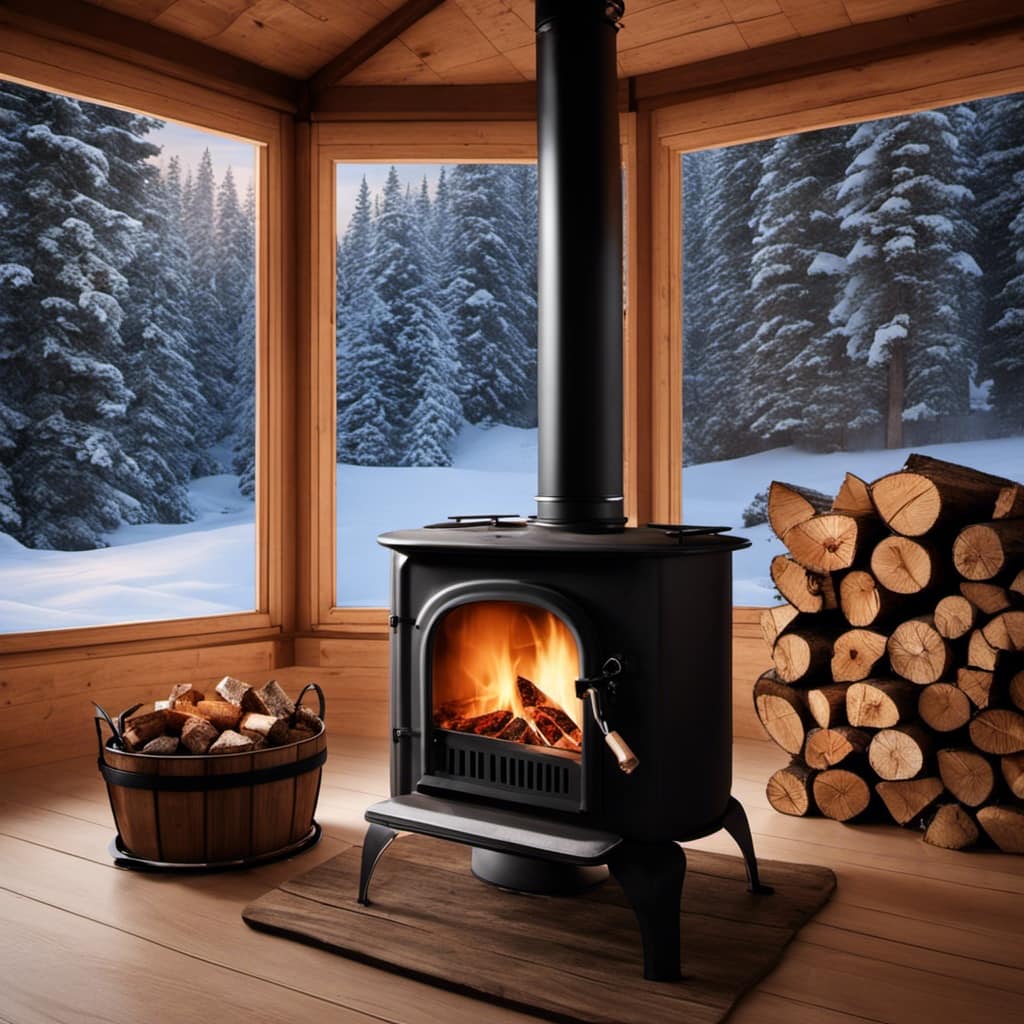
Non-Scratch Cleaning Methods
I find that using a microfiber cloth is the best way to clean glass on a wood stove without scratching it. Microfiber is an excellent choice because it’s soft and non-abrasive, ensuring that your glass remains in pristine condition. Here are four gentle cleaning methods you can try:
-
Homemade Glass Cleaner: Mix equal parts vinegar and water in a spray bottle. Spray the solution onto the glass and wipe it clean with the microfiber cloth.
-
Baking Soda Paste: Make a paste by mixing baking soda with water. Apply the paste to the glass using the microfiber cloth and gently scrub in circular motions. Rinse thoroughly with water.
-
Dish Soap Solution: Dilute a few drops of dish soap in water. Dampen the microfiber cloth with the solution and wipe down the glass, removing any dirt or grime.
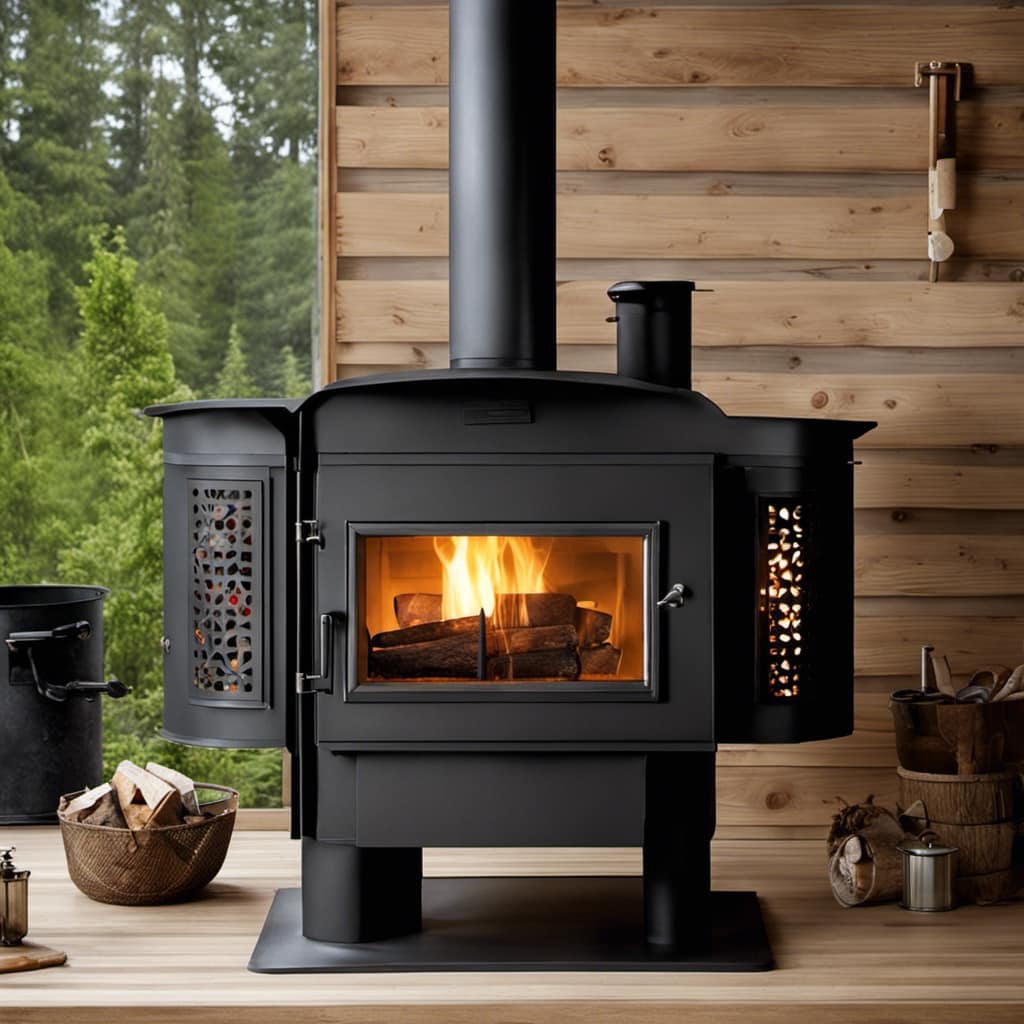
-
Lemon Juice and Salt: Create a mixture of lemon juice and salt. Apply the mixture to the glass and scrub gently with the microfiber cloth. Rinse with water.
By using these gentle cleaning methods, you can effectively remove dirt and grime from your wood stove glass without causing any scratches.
Now, let’s move on to the next section and explore how to remove stubborn soot stains.
Removing Stubborn Soot Stains
To tackle those tough soot stains, I find that using a mixture of vinegar and baking soda creates an effective cleaning solution. This natural cleaning method is not only safe for the environment but also gentle on the glass surface of the wood stove. Here is a table that shows the steps to follow when using this cleaning solution:
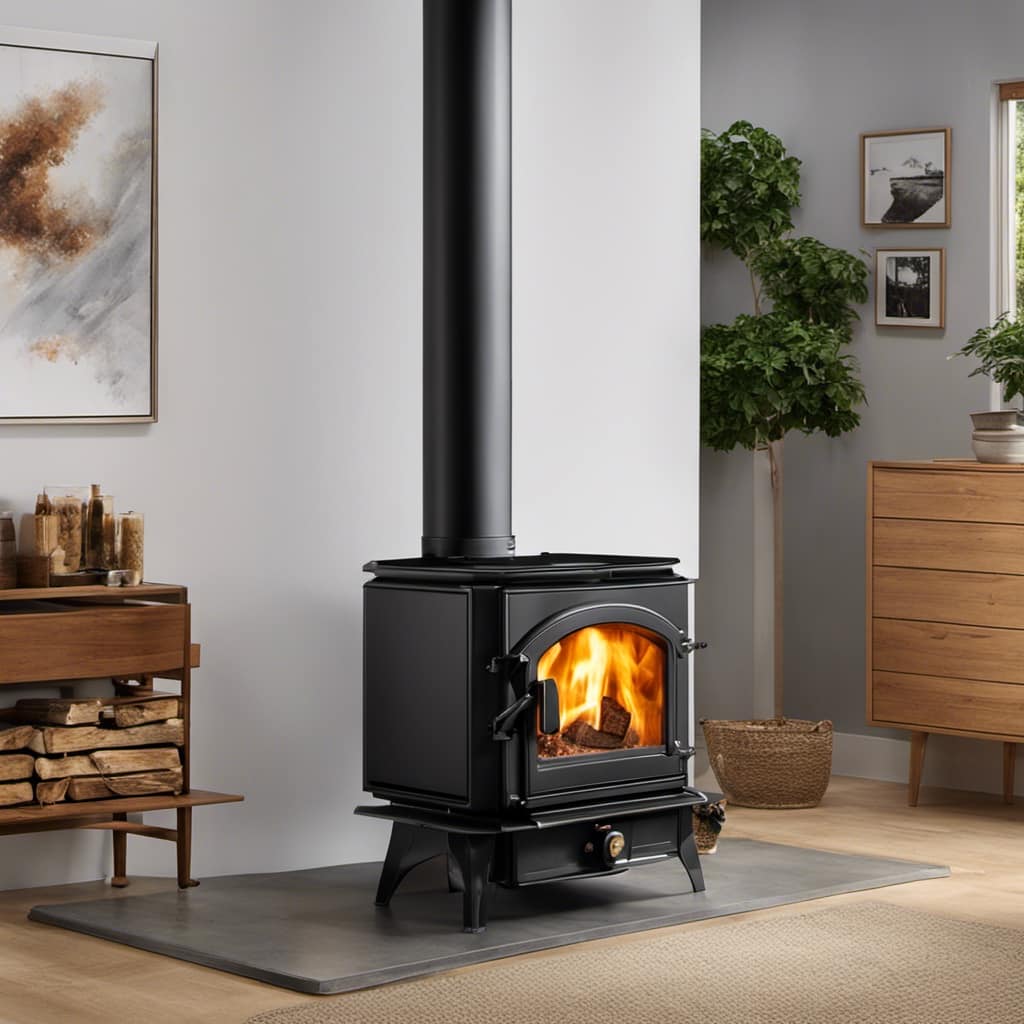
| Step | Instructions |
|---|---|
| 1 | Mix equal parts of vinegar and baking soda in a bowl. |
| 2 | Apply the mixture to a damp cloth or sponge. |
| 3 | Gently scrub the soot stains on the glass surface. |
| 4 | Rinse the glass with clean water. |
| 5 | Dry the glass with a soft, lint-free cloth. |
While using natural cleaning methods like vinegar and baking soda can effectively remove stubborn soot stains, there may be instances where seeking professional help is necessary, especially in cases of heavy buildup or damage to the glass. However, for regular maintenance and light stains, this method can provide satisfactory results. Now, let’s move on to the next section to learn about removing residue with a vinegar and water solution.
Removing Residue With Vinegar and Water Solution
The vinegar and water solution effectively removes residue from the glass on my wood stove. I’ve found this method to be efficient and safe for cleaning the glass, leaving it clear and sparkling. Here are some key points to consider when using this solution:
- Mix equal parts of white vinegar and water in a spray bottle.
- Spray the solution onto the glass, ensuring complete coverage.
- Let the solution sit for a few minutes to allow it to break down the residue.
- Use a soft cloth or sponge to gently scrub the glass in circular motions.
Alternative glass cleaning methods can also be effective in removing residue from the glass on your wood stove. Some options include using a mixture of baking soda and water, or a commercial glass cleaner specifically designed for wood stoves.
To prevent residue buildup on the glass, here are some useful tips:
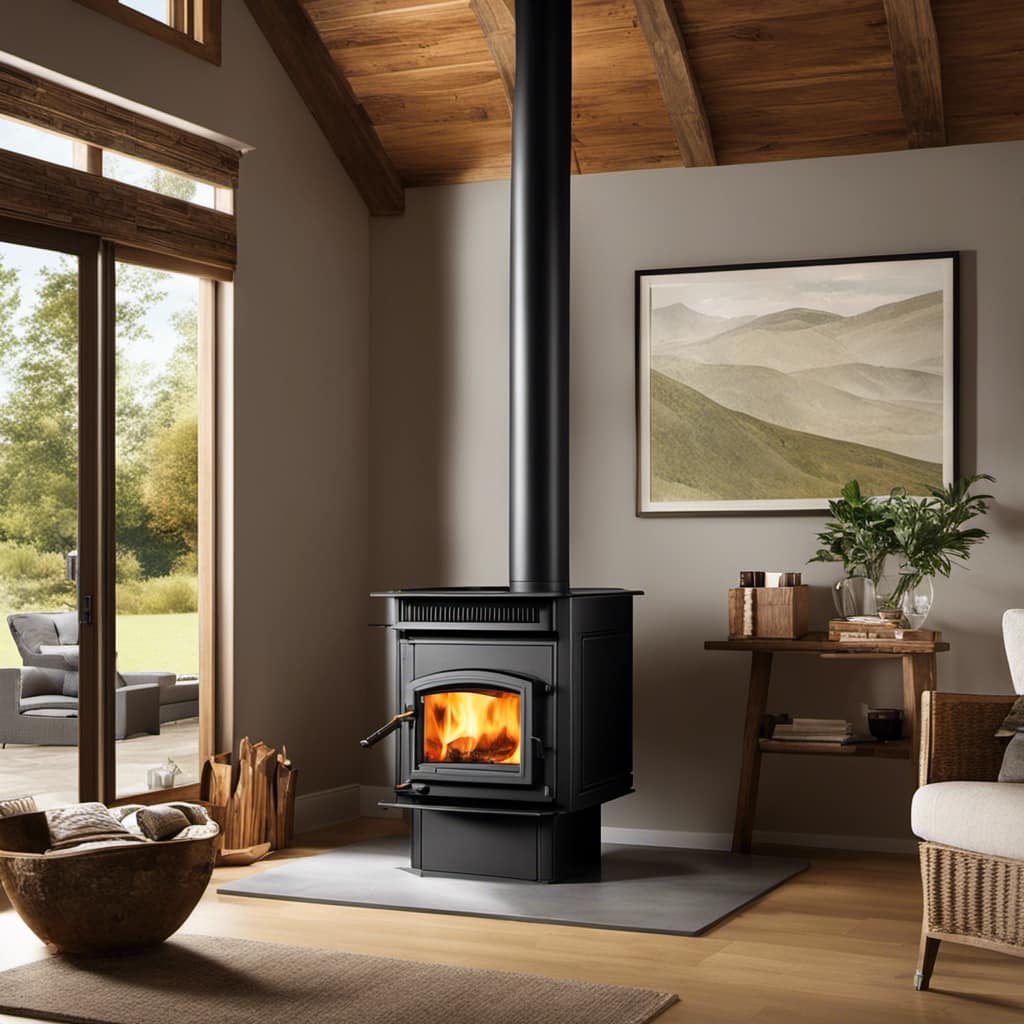
- Burn dry, seasoned firewood to minimize the amount of smoke and soot produced.
- Keep the air vents open to ensure proper airflow and combustion, reducing the likelihood of residue buildup.
- Regularly clean the glass using the vinegar and water solution or other appropriate cleaning methods.
- Consider using a stove fan or an air purifier to help circulate the air and reduce the amount of residue that accumulates on the glass.
Polishing the Glass for a Clear and Sparkling Finish
Using a soft cloth and a glass cleaner specifically designed for my wood stove, I gently polish the glass to achieve a clear and sparkling finish. Polishing the glass not only improves its appearance but also helps to prevent the buildup of residue and soot.
To ensure the best results, I follow specific polishing techniques and take steps to prevent streaks.
First, I make sure the glass is cool to the touch before starting the polishing process. This prevents any potential damage to the glass or injuries to myself.
Next, I spray the glass cleaner directly onto the cloth, rather than directly onto the glass. This helps to control the amount of cleaner used and prevents overspray onto other surfaces.

I then begin polishing the glass in a circular motion, applying gentle pressure. This helps to remove any stubborn residue or streaks. I make sure to cover the entire surface of the glass, paying extra attention to any areas that may have heavier buildup.
To prevent streaks, I make sure to use a clean section of the cloth for each pass. This ensures that any residue or cleaner is effectively removed and not spread around. Additionally, I avoid using excessive amounts of cleaner, as this can lead to streaking.
Maintaining Clean Glass for Safe and Efficient Wood Stove Operation
Maintaining clear and sparkling glass on my wood stove is crucial for safe and efficient operation. Regular glass maintenance ensures that my wood stove operates at its best and reduces the risk of accidents. To keep my glass clean, I follow these steps:
-
Inspect the glass: Before cleaning, I carefully inspect the glass for any cracks or damage. If I notice any issues, I contact a professional for repairs.
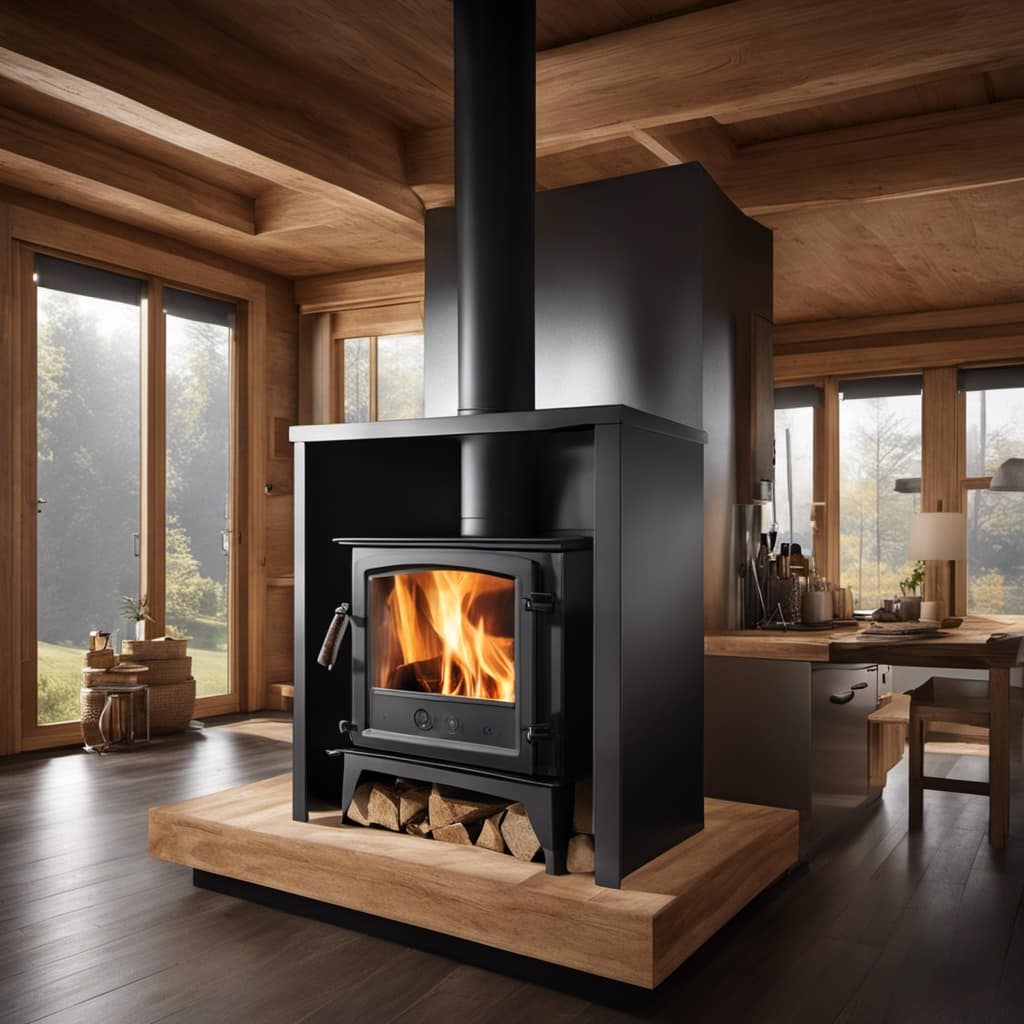
-
Gather the necessary supplies: I gather a soft cloth, a glass cleaner specifically designed for wood stoves, and a pair of protective gloves.
-
Safety precautions: I take safety precautions while cleaning the glass. This includes wearing gloves to protect my hands and ensuring that the stove is cool before starting the cleaning process.
-
Clean the glass: I spray the glass cleaner onto the cloth and gently wipe the surface of the glass in a circular motion. I pay extra attention to any stubborn stains or soot buildup. Once the glass is clean, I use a dry cloth to remove any excess cleaner and leave it sparkling.
Frequently Asked Questions
How Often Should I Clean the Glass on My Wood Stove?
I clean the glass on my wood stove regularly to ensure optimal performance and maintain a clear view of the fire.
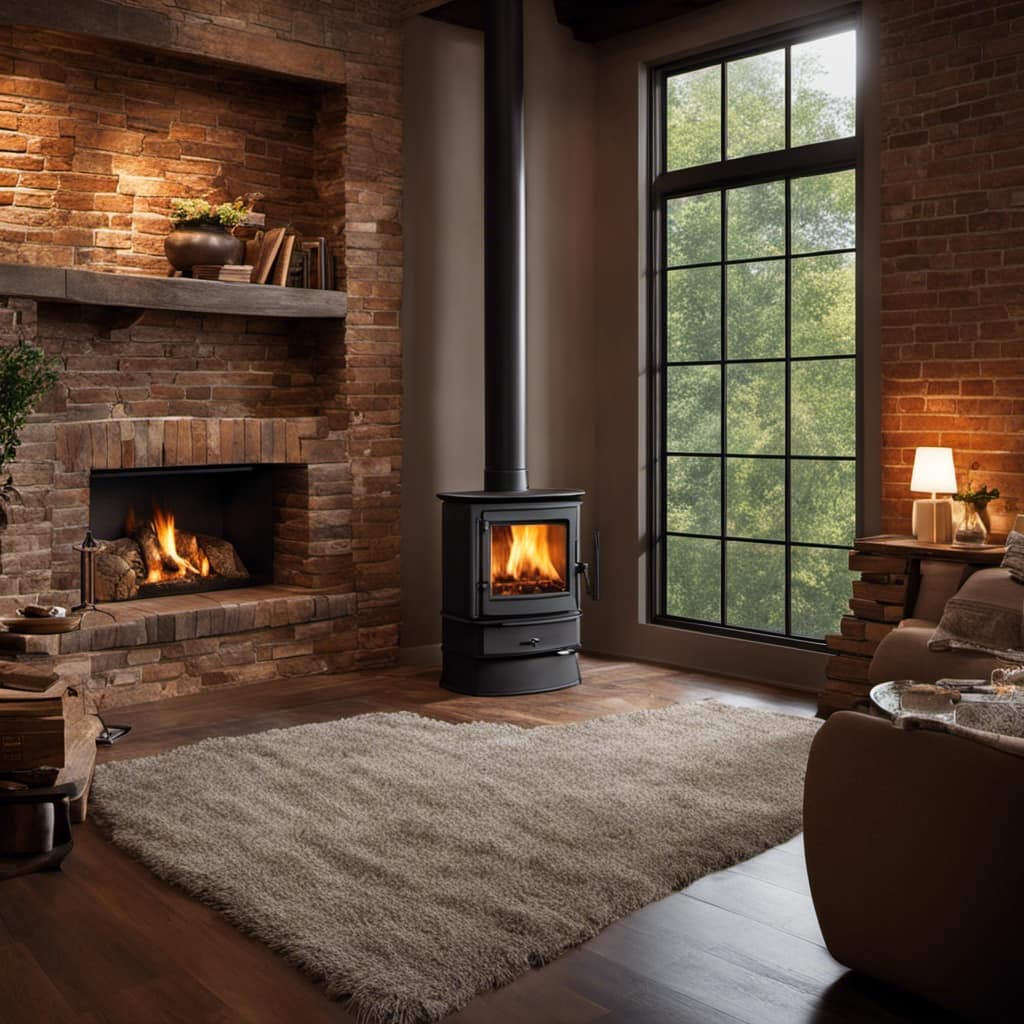
By preventing the glass from getting dirty, I reduce the risk of it becoming permanently stained or damaged.
To clean the glass, I use a specialized glass cleaner or a mixture of vinegar and water, along with a soft cloth or sponge.
Regular maintenance and cleaning help to keep the glass on my wood stove looking clean and clear.
Can I Use Any Type of Glass Cleaner on My Wood Stove?
I recommend using caution when selecting a glass cleaner for your wood stove. While many cleaning products are safe for regular glass, they may not be suitable for the specific type of glass used in wood stoves.
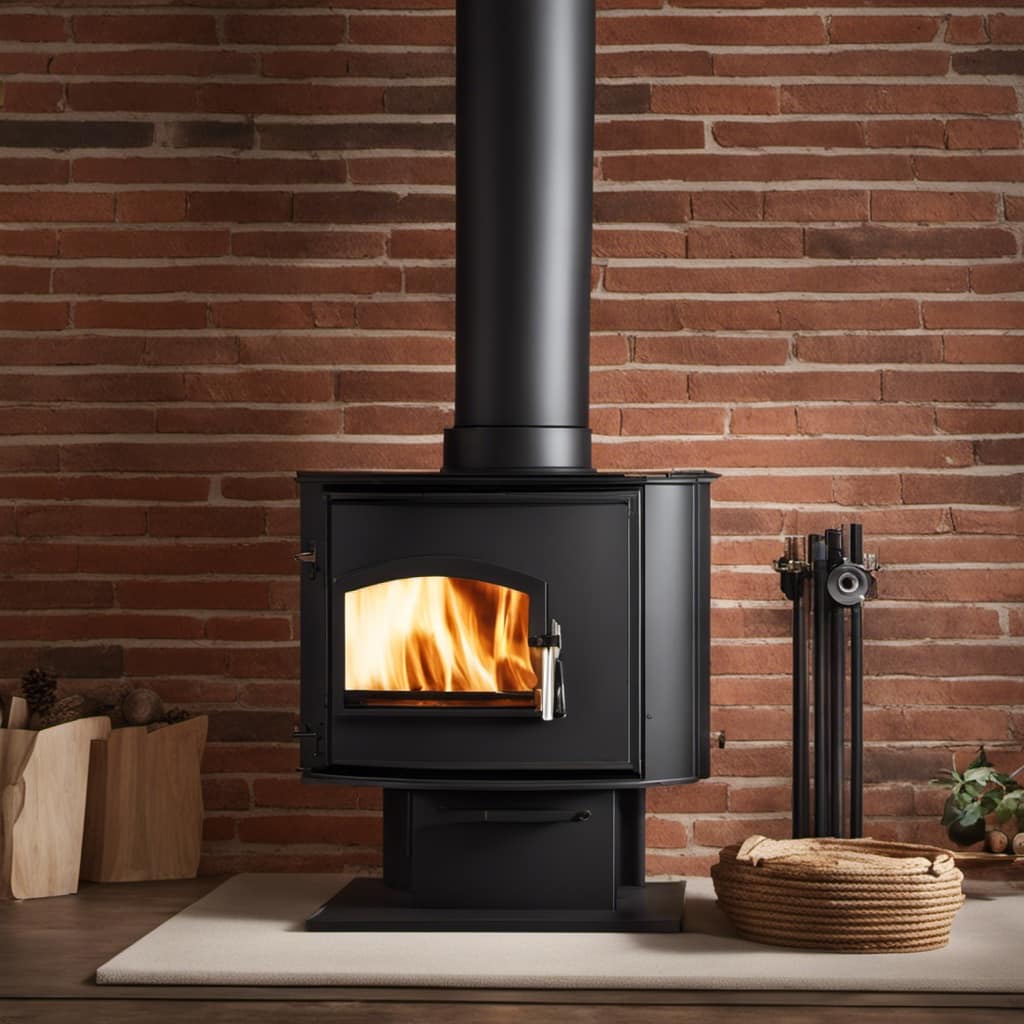
It’s important to consult the manufacturer’s guidelines or contact a professional for advice on the best cleaning methods and products.
If you prefer alternative cleaning methods, there are natural solutions like vinegar and water that can be effective in removing dirt and grime from the glass.
Is It Necessary to Remove the Glass From the Stove Before Cleaning?
Removing the glass from the wood stove before cleaning has both pros and cons. On one hand, removing the glass allows for easier access and thorough cleaning of all sides. On the other hand, it can be time-consuming and may require additional tools.
If you prefer not to remove the glass, there are alternative methods for cleaning wood stove glass. These include using a specialized glass cleaner or a mixture of vinegar and water.
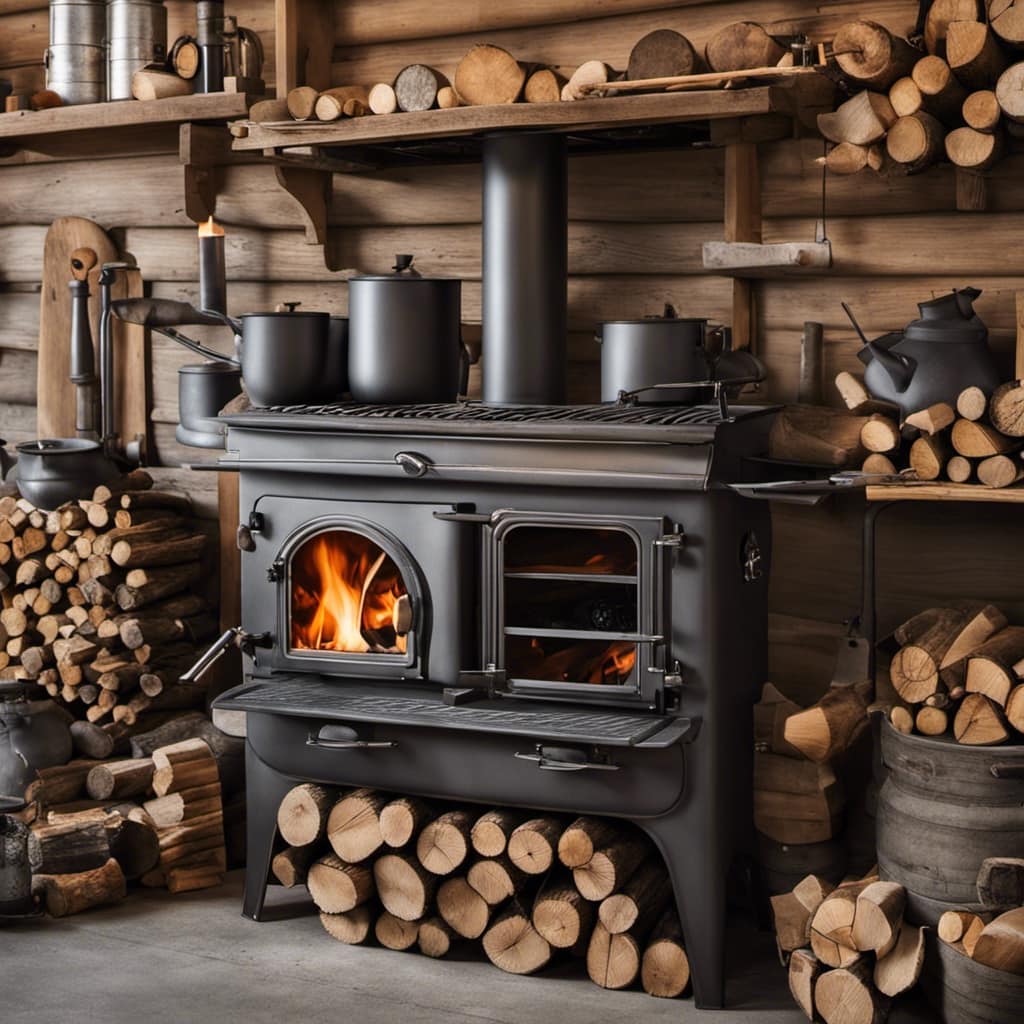
What Should I Do if There Are Stubborn Stains or Buildup on the Glass?
When dealing with stubborn stains or buildup on the glass of my wood stove, I rely on effective cleaning solutions and techniques.
To remove tough stains, I mix a solution of vinegar and water and apply it to the glass. Letting it sit for a few minutes helps to loosen the buildup.
Then, using a non-abrasive scrub brush, I gently scrub the glass in circular motions.
Are There Any Specific Safety Precautions I Should Take While Cleaning the Glass on My Wood Stove?
When it comes to cleaning the glass on my wood stove, I always make sure to take specific safety precautions.
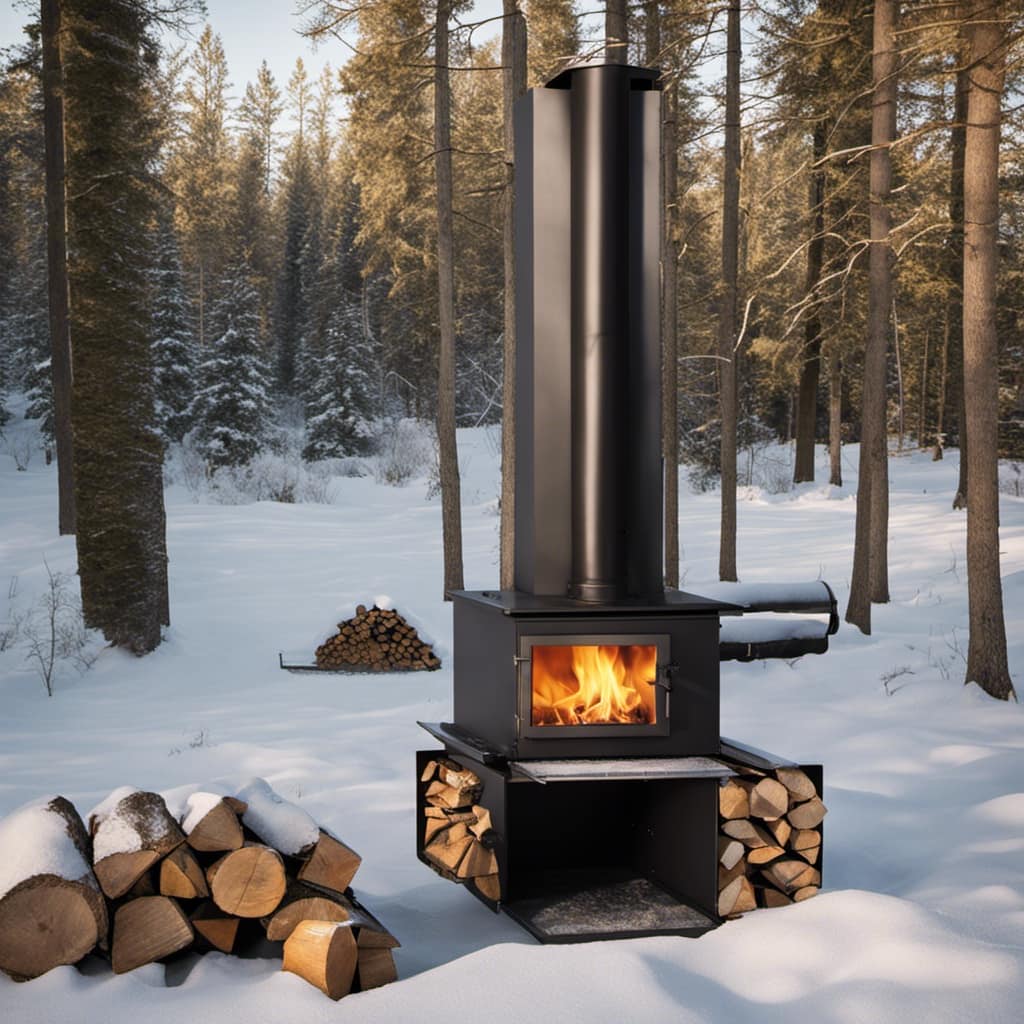
First, I ensure that the stove is completely cool before beginning any cleaning. I also wear protective gloves and eyewear to prevent any potential injuries.
As for the cleaning techniques, I use a non-abrasive glass cleaner and a soft cloth to gently remove any stains or buildup.
It’s important to follow these safety precautions to avoid any accidents or damage.
Conclusion
In conclusion, regularly cleaning the glass on your wood stove is crucial for safe and efficient operation. By following the steps outlined in this article, you can easily remove stubborn soot and residue from the glass surface.
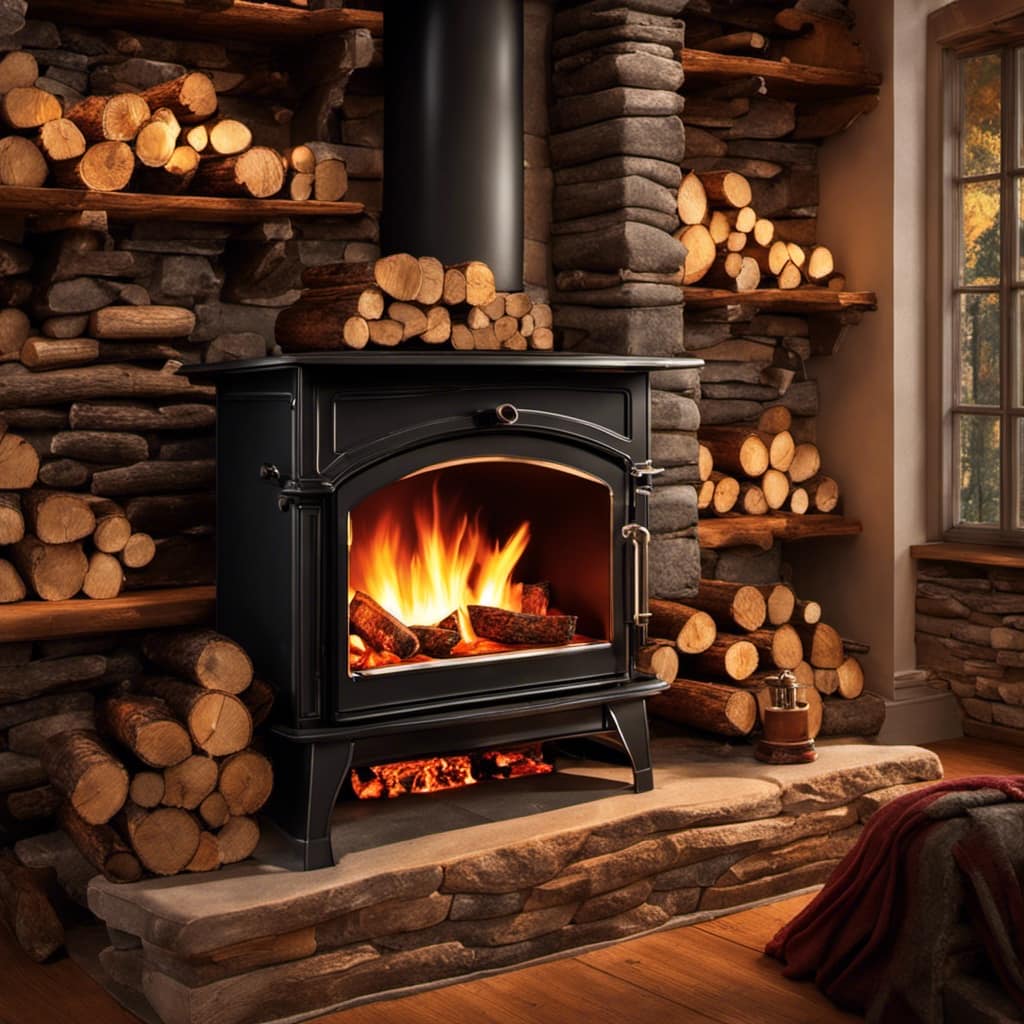
While some may argue that cleaning the glass is time-consuming, the benefits of better visibility and improved stove performance outweigh the effort required.
Remember to maintain clean glass to ensure a clear and sparkling finish for optimal wood stove operation.
Growing up surrounded by the vast beauty of nature, Sierra was always drawn to the call of the wild. While others sought the comfort of the familiar, she ventured out, embracing the unpredictable and finding stories in the heartbeat of nature.
At the epicenter of every remarkable venture lies a dynamic team—a fusion of diverse talents, visions, and passions. The essence of Best Small Wood Stoves is crafted and refined by such a trio: Sierra, Logan, and Terra. Their collective expertise has transformed the platform into a leading authority on small wood stoves, radiating warmth and knowledge in equal measure.




